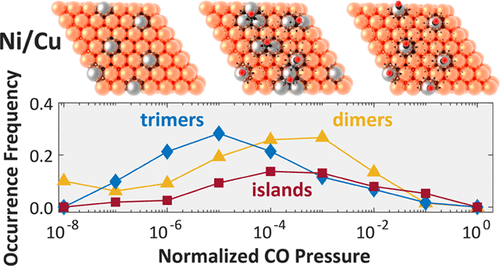当前位置:
X-MOL 学术
›
ACS Catal.
›
论文详情
Our official English website, www.x-mol.net, welcomes your
feedback! (Note: you will need to create a separate account there.)
Engineering the Surface Architecture of Highly Dilute Alloys: An ab Initio Monte Carlo Approach
ACS Catalysis ( IF 11.3 ) Pub Date : 2019-12-30 , DOI: 10.1021/acscatal.9b04029 Konstantinos G. Papanikolaou 1 , Matthew T. Darby 1 , Michail Stamatakis 1
ACS Catalysis ( IF 11.3 ) Pub Date : 2019-12-30 , DOI: 10.1021/acscatal.9b04029 Konstantinos G. Papanikolaou 1 , Matthew T. Darby 1 , Michail Stamatakis 1
Affiliation

|
Highly dilute alloys of platinum group metals (PGMs: Pt, Rh, Ir, Pd, and Ni) with coinage metals (Cu, Au, and Ag) serve as highly selective and coke-resistant catalysts in a number of applications. The catalytic behavior of these materials is governed by the size and shape of the surface “ensembles” of PGM atoms. Therefore, establishing a means of control over the topological architecture of highly dilute alloy surfaces is crucial to optimizing their catalytic performance. In the present work, we use on-lattice Monte Carlo simulations that are parameterized by density functional theory-derived energetics to investigate the surface aggregation of PGM atoms under vacuum conditions and in the presence of CO. We study several highly dilute alloy surfaces at various PGM loadings, including Pd/Au(111), Pd/Ag(111), Pt/Cu(111), Rh/Cu(111), Ir/Ag(111), and Ni/Cu(111). Under vacuum conditions, we observe a thermodynamic preference for dispersion of PGM as single atoms in the surface of the coinage metal host, on all examined alloy surfaces except Ir/Ag(111), where Ir atom aggregation and island formation is preferred. By evaluating the alloy surface structure in the presence of CO, we determine that the size and shape of PGM ensembles can be manipulated by tuning the partial pressure of CO (PCO) on the Pd/Au(111), Pd/Ag(111), Ir/Ag(111), and Ni/Cu(111) surfaces. In contrast, we determine that Pt/Cu(111) and Rh/Cu(111) highly dilute alloys are unresponsive to changes in PCO with Rh and Pt dispersing as isolated single atoms within the host matrix, irrespective of gaseous composition. Our findings suggest that it may be possible to fine-tune the surface architecture of highly dilute binary alloys for optimized catalytic performance.
中文翻译:

从头开始蒙特卡洛方法设计高稀释合金的表面结构
铂族金属(PGM:Pt,Rh,Ir,Pd和Ni)与造币金属(Cu,Au和Ag)的高度稀薄合金在许多应用中用作高度选择性和耐焦化的催化剂。这些材料的催化行为取决于PGM原子表面“集合”的大小和形状。因此,建立一种控制高度稀合金表面拓扑结构的方法对于优化其催化性能至关重要。在目前的工作中,我们使用由密度泛函理论派生的能量学参数化的晶格蒙特卡洛模拟,研究在真空条件下和存在CO的情况下PGM原子的表面聚集。 PGM负载,包括Pd / Au(111),Pd / Ag(111),Pt / Cu(111),Rh / Cu(111),Ir / Ag(111),Ni / Cu(111)。在真空条件下,我们观察到在除Ir / Ag(111)以外的所有检测合金表面上,PGM作为单原子分散在造币金属主体表面的热力学偏好,其中Ir原子聚集和形成岛是优选的。通过评估存在CO的合金表面结构,我们确定可以通过调节CO的分压来控制PGM团的大小和形状。Pd / Au(111),Pd / Ag(111),Ir / Ag(111)和Ni / Cu(111)表面上的P CO)。与此相反,我们确定了Pt /铜(111)和Rh /铜(111)高度稀释的合金是不响应的变化P CO与Rh和铂分散作为主体基质内的分离的单原子,不论气态组合物。我们的发现表明,可能会微调高度稀释的二元合金的表面结构,以优化催化性能。
更新日期:2019-12-30
中文翻译:

从头开始蒙特卡洛方法设计高稀释合金的表面结构
铂族金属(PGM:Pt,Rh,Ir,Pd和Ni)与造币金属(Cu,Au和Ag)的高度稀薄合金在许多应用中用作高度选择性和耐焦化的催化剂。这些材料的催化行为取决于PGM原子表面“集合”的大小和形状。因此,建立一种控制高度稀合金表面拓扑结构的方法对于优化其催化性能至关重要。在目前的工作中,我们使用由密度泛函理论派生的能量学参数化的晶格蒙特卡洛模拟,研究在真空条件下和存在CO的情况下PGM原子的表面聚集。 PGM负载,包括Pd / Au(111),Pd / Ag(111),Pt / Cu(111),Rh / Cu(111),Ir / Ag(111),Ni / Cu(111)。在真空条件下,我们观察到在除Ir / Ag(111)以外的所有检测合金表面上,PGM作为单原子分散在造币金属主体表面的热力学偏好,其中Ir原子聚集和形成岛是优选的。通过评估存在CO的合金表面结构,我们确定可以通过调节CO的分压来控制PGM团的大小和形状。Pd / Au(111),Pd / Ag(111),Ir / Ag(111)和Ni / Cu(111)表面上的P CO)。与此相反,我们确定了Pt /铜(111)和Rh /铜(111)高度稀释的合金是不响应的变化P CO与Rh和铂分散作为主体基质内的分离的单原子,不论气态组合物。我们的发现表明,可能会微调高度稀释的二元合金的表面结构,以优化催化性能。











































 京公网安备 11010802027423号
京公网安备 11010802027423号